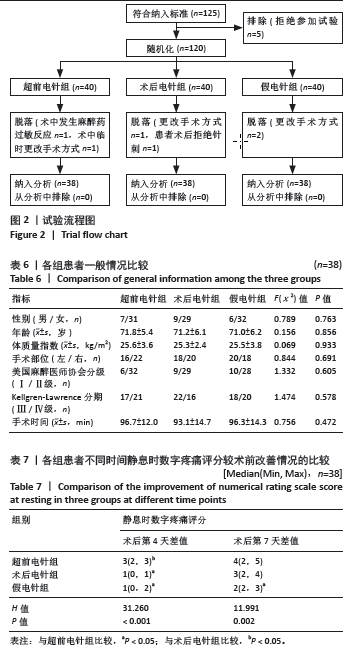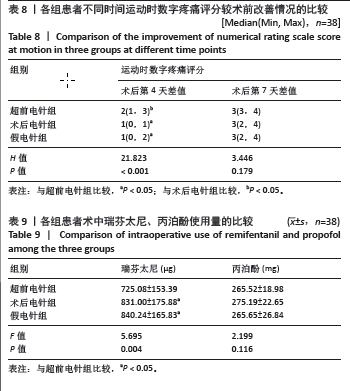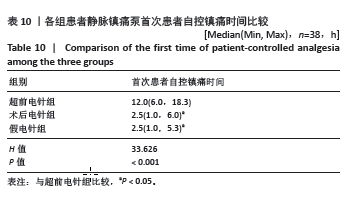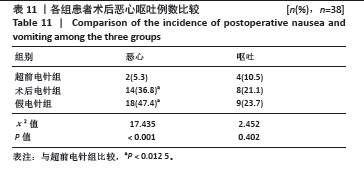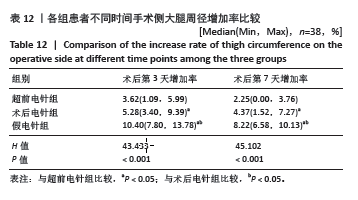[1] KANG K, TIEN T, LEE M, et al. Suitability of Metal Block Augmentation for Large Uncontained Bone Defect in Revision Total Knee Arthroplasty (TKA). J Clin Med. 2019;8(3):384.
[2] CARR AJ, ROBERTSSON O, GRAVES S, et al. Knee replacement. Lancet. 2012;379(9823):1331-1340.
[3] LAVAND’HOMME PM, KEHLET H, RAWAL N, et al. Pain management after total knee arthroplasty: Procedure Specific Postoperative Pain Management recommendations. Eur J Anaesthesiol. 2022;39(9):743-757.
[4] RAMLALL Y, ANDRION JJD, CAMERON HU, et al. Examining pain before and after primary total knee replacement (TKR): A retrospective chart review. Int J of Orthop Trauma Nurs. 2019;34:43-47.
[5] SZÖTS K, PEDERSEN PU, HØRDAM B, et al. Physical health problems experienced in the early postoperative recovery period following total knee replacement. Int J Orthop Trauma Nurs. 2015;19(1):36-44.
[6] 周宗科,廖刃,唐佩福,等.中国骨科手术加速康复围手术期疼痛管理指南[J].中华骨与关节外科杂志,2019,12(12):929-938.
[7] 刘娅楠,侯怀晶,薛建军,等.全膝关节置换术后疼痛机制与针刺镇痛研究进展[J].西部中医药,2020,33(4):146-150.
[8] SHAH S, GODHARDT L, SPOFFORD C. Acupuncture and Postoperative Pain Reduction. Curr Pain Headache Rep. 2022;26(6):453-458.
[9] 孙若晗,徐赟赟,胡汉通,等.巨刺的理论基础及应用时机探讨[J].中华中医药杂志,2021,36(4):1972-1974.
[10] MENGHAN L, YAN Y, SHIZHE D, et al. Contralateral needling at the foot of unaffected side combining with rehabilitation treatment for motor dysfunction of hand after ischemic stroke: study protocol for a randomized controlled pilot trial. J Tradit Chin Med. 2023;43(5):1034-1039.
[11] XUAN C, YAN W, WANG D, et al. Efficacy of preemptive analgesia treatments for the management of postoperative pain: a network meta-analysis. Br J Anaesth. 2022;129(6):946-958.
[12] GONÇALVES DE FREITAS ATA, LEMONICA L, DE FAVERI J, et al. Preemptive Analgesia with Acupuncture Monitored by c-Fos Expression in Rats. J Acupunct Meridian Stud. 2016;9(1):16-21.
[13] LISZKA H, ZAJĄC M, GĄDEK A. Pre-emptive analgesia with methylprednisolone and gabapentin in total knee arthroplasty in the elderly. Sci Rep. 2022;12(1):2320.
[14] ZHOU Y, LIU X, DING C, et al. Positive Preemptive Analgesia Effectiveness of Pregabalin Combined with Celecoxib in Total Knee Arthroplasty: A Prospective Controlled Randomized Study. Pain Res Manag. 2023;2023: 1-10.
[15] YANG EJ, KOO ST, KIM YS, et al. Contralateral electroacupuncture pretreatment suppresses carrageenan-induced inflammatory pain via the opioid-mu receptor. Rheumatol Int. 2011;31(6):725-730.
[16] 樊子娟,王桂杉,李川,等.《中国骨关节炎诊疗指南(2021年版)》解读和评价[J].中国循证医学杂志,2022,22(6):621-627.
[17] 中华中医药学会骨伤科分会膝痹病(膝骨关节炎)临床诊疗指南制定工作组. 中医骨伤科临床诊疗指南·膝痹病(膝骨关节炎)[J].康复学报,2019,29(3):1-7.
[18] 谭亚芹,马昕婷,王琦,等.国家标准《腧穴名称与定位》(GB/T 12346-2006)使用情况调查研究[J].中国针灸,2016,36(8):871-874.
[19] 李冰,赵占强,柳舒扬,等.经皮穴位电刺激对腹腔镜胆囊切除术后应激反应及胃肠功能的影响[J].临床麻醉学杂志,2023,39(4): 379-383.
[20] PINSORNSAK P, ROJANAVIJITKUL S, CHUMCHUEN S. Peri-articular tranexamic acid injection in total knee arthroplasty: a randomized controlled trial. BMC Musculoskeletal Disord. 2016;17(1):313.
[21] LIU Z, XU H, CHEN Y, et al. The efficacy and safety of electroacupuncture for women with pure stress urinary incontinence: study protocol for a multicenter randomized controlled trial. Trials. 2013;14(1):315.
[22] KATZ JN, ARANT KR, LOESER RF. Diagnosis and Treatment of Hip and Knee Osteoarthritis: A Review. JAMA. 2021;325(6):568-578.
[23] LIU Y, XIAO S, YANG H, et al. Postoperative pain-related outcomes and perioperative pain management in China: a population-based study. Lancet Reg Health West Pac. 2023;39:100822.
[24] SMALL C, LAYCOCK H. Acute postoperative pain management. Br J Surg. 2020;107(2):e70-e80.
[25] DE LADOUCETTE A. Management of perioperative pain after TKA. Orthop Traumatol Surg Res. 2023;109(1):103443.
[26] XUAN C, YAN W, WANG D, et al. Efficacy of preemptive analgesia treatments for the management of postoperative pain: a network meta-analysis. Br J Anaesth. 2022;129(6):946-958.
[27] 李蔚,赵华,吴君怡,等.针灸在手术超前镇痛中的临床应用进展[J].中医药导报,2016,22(16):93-95.
[28] BRINCK E, TIIPPANA E, HEESEN M, et al. Perioperative intravenous ketamine for acute postoperative pain in adults. Cochrane Database Syst Rev. 2018;12(12):CD012033.
[29] 闫向彪,韩学昌,邢群智,等.电针内麻点和内关穴与硬膜外神经阻滞在胸科手术患者超前镇痛的对比研究[J].中国针灸,2021, 41(1):59-64.
[30] SCHIFF E, ATTIAS S, MATTER I, et al. Complementary and alternative medicine interventions for perioperative symptoms: A comparative effectiveness study. Complement Ther Med. 2019;44:51-55.
[31] ACAR HV. Acupuncture and related techniques during perioperative period: A literature review. Complement Ther Med. 2016;29:48-55.
[32] 权隆芳,贾小强,李东冰,等.不同时间电针对直肠癌开腹手术患者围术期应激反应和免疫功能的影响[J].上海针灸杂志,2020, 39(3):330-338.
[33] ZHU J, LI S, WU W, et al. Preoperative electroacupuncture for postoperative nausea and vomiting in laparoscopic gynecological surgery: a randomized controlled trial. Acupunct Med. 2022;40(5): 415-424.
[34] PIRES MC, BARROS GAMD, FONSECA LGF, et al. Effects of Preoperative Acupuncture on Prevention of Nausea and Vomiting and Plasma Serotonin Values in the Hysterectomy Postoperative Period: a Randomized Clinical Trial. J Acupunct Meridian Stud. 2022;15(5):300-306.
[35] ZHANG C, YAN CH, CHAN PK, et al. A Randomized Controlled Study on the Use of Tourniquet in Primary Total Knee Arthroplasty. J Knee Surg. 2022;35(6): 698-706.
[36] 刘玥,安冬卫.针刺配合推拿手法治疗骨折后期肢体肿胀的疗效分析[J].山西医药杂志,2021,50(5):837-839.
[37] WU MS, CHEN KH, CHEN IF, et al. The Efficacy of Acupuncture in Post-Operative Pain Management: A Systematic Review and Meta-Analysis. PLoS One. 2016;11(3):e0150367.
[38] XU Z, ZHU Y, SHEN J, et al. Pain Relief Dependent on IL-17–CD4+ T Cell–β-Endorphin Axis in Rat Model of Brachial Plexus Root Avulsion After Electroacupuncture Therapy. Front Neurosci. 2021;14: 596780.
[39] 赵翅,许辉,康冰心,等.基于数据挖掘分析针灸治疗全膝关节置换术后急性疼痛的选穴规律[J].西部中医药,2023,36(4):63-67.
[40] 康冰心,肖涟波,赵翅,等.电针联合塞来昔布治疗全膝关节置换术后疼痛的疗效观察[J].中国中西医结合杂志,2022,42(10): 1169-1174. |
